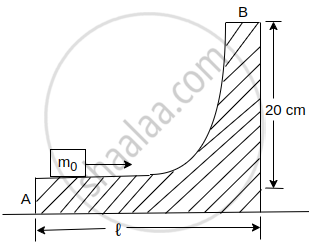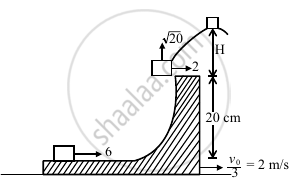Advertisements
Advertisements
प्रश्न
A wedge of mass M = 2m0 rests on a smooth horizontal plane. A small block of mass m0 rests over it at left end A as shown in the figure. A sharp impulse is applied on the block, due to which it starts moving to the right with velocity v0 = 6 m/s. At the highest point of its trajectory, the block collides with a particle of the same mass m0 moving vertically downwards with velocity v = 2 m/s, and gets stuck with it. If the combined mass lands at the end point A of the body of mass M, the length l is ______ cm. Neglect friction, take g = 10 m/s2.

विकल्प
10.00
20.00
30.00
40.00
उत्तर
A wedge of mass M = 2m0 rests on a smooth horizontal plane. A small block of mass m0 rests over it at left end A as shown in the figure. A sharp impulse is applied on the block, due to which it starts moving to the right with velocity v0 = 6 m/s. At the highest point of its trajectory, the block collides with a particle of the same mass m0 moving vertically downwards with velocity v = 2 m/s, and gets stuck with it. If the combined mass lands at the end point A of the body of mass M, the length l is 40.00 cm. Neglect friction, take g = 10 m/s2.
Explanation:

At the highest point, combined mass velocity is,

H = `20/(2g)` = 1 m
1.2 = 1.T + `1/2` g T2
T = 0.4 sec
urel = 1 m/s
⇒ l = urel T = 0.4 m
= 40 cm
